 |
||
|
||
| ||
Scythe, Titan, and ZalmanContents:
Scythe Minebea 12cm Mid and Minebea 12cm HighThe next objects of our shootout are two High-End fans — Scythe Minebea 12cm Mid (4710KL-04W-B19) and Minebea 12cm High (4710KL-04W-B29) designed by the leader of this industry, NMB-Matsushita corporation, and produced by the famous Japanese brand Scythe. 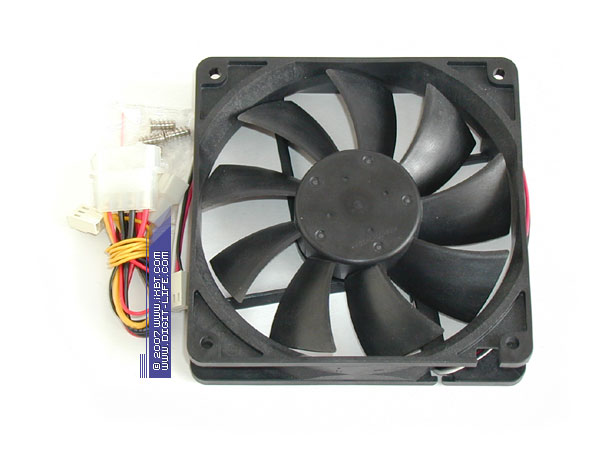 Scythe Minebea 12cm Mid Keeping in mind prestige and achievements of NMB-Matsushita (both the conglomerate as a whole and its constituent companies separately), we can safely assume that Minebea fans must demonstrate the optimal combination of quality and functionality, spiced up with well thought-out and neat engineering approach. They come up to our expectations even under scrutiny and completely lend credence to their High-End status. 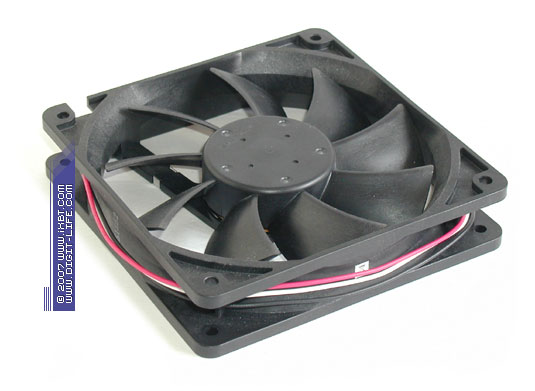 The 9-blade impeller has a very interesting aerodynamic configuration, which is designed for maximum performance with acceptable noise ergonomics — sweep and lean blades, chord - 20 mm at the hub and 30 mm at the tip, chord-pitch ratio is 1.25 at the hub and 0.79 at the tip, aggressive angles of attack - 50° and 35°, 0.41 hub-tip ratio, 1.5 mm tip clearance. Minebea's impeller also has three aerodynamic benefactors that reduce the noise and raise its efficiency — a screen on the front edge of the blade, dihedral blade, and smoothed rear edge of the blade.  We should pay special attention to Minebea mechanics based on two ball bearings. The focus is on quality here - we get it owing to high-precision NMB bearings. In their turn, they guarantee as small clearance between the hub and the inner ring of the bearing as possible (no backlash), vibration stability, enhanced reliability (resistance to mechanic stresses), and optimized noise characteristics (these bearings do not crackle and practically don't "hiss"). 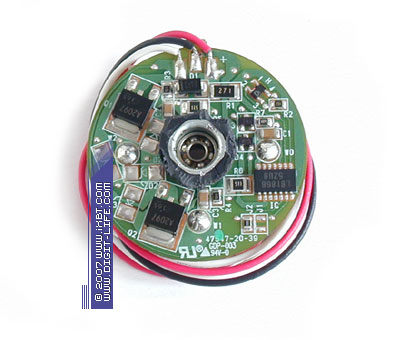 Silent IC Another feature of Minebea fans is their advanced electric binding of the engine called Silent IC. The integrated controller is based on Sanyo LB1868M (a counterpart of LB1668M). Interestingly, the outputs of inductor's drivers use integrating circuits (a couple of resistors, a key bipolar transistor, and an integrating capacitor between the base and collector) instead of capacitors. Integrators efficiently protract the front-decay of switching impulses in the inductor coil. As a result, this IC stands up to its title — Minebea 4710KL-04W-B19 and 4710KL-04W-B29 are the only fans today without electric popping in their noise. Minebea fans look great from the practical point of view as well. They achieve excellent results with acceptable noise ergonomics. They demonstrate the highest performance at nominal speed (1900 rpm for the 4710KL-04W-B29 and 1600 rpm for Minebea 4710KL-04W-B19). But the noise level grows rather high in this mode, which makes them less attractive in the standard mode. Their real potential is revealed at moderate speed — they demonstrate good universality of the impeller, spiced up with ergonomic noise characteristics. So they provide the best efficiency/noise ratio. Minebea 12cm Mid and Minebea 12cm High are very interesting products with excellent technical properties. Our only gripe is their prices: their average retail price is $18, which makes them the most expensive fans in the market. This price is too high in our opinion, even for High-End. But it cannot be helped — High-End requires sacrifices. :) Our shootout also includes Scythe Minebea 9cm Mid and Minebea 9cm High (92x92x25 mm) hors concours. 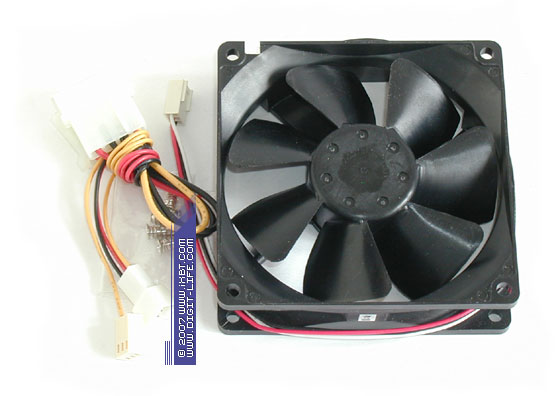
 In technical terms, they are similar to Minebea 12cm (two ball bearings, Silent IC) and differ in highly efficient aerodynamics. We'll review these fans in one of our future articles. Scythe S-Flex SFF21E and SFF21FThe other two High-End fans from Scythe (S-Flex SFF21E and SFF21F) are based on a technically different idea and have different performance roots (manufacturer — ADDA). 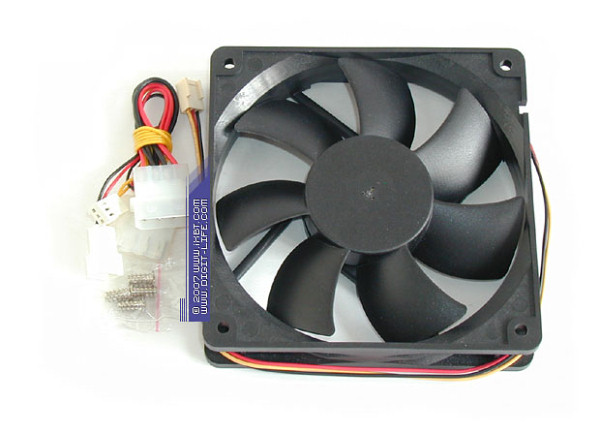 Scythe S-Flex SFF21F The main peculiarity of the SFF21E and SFF21F fans is advanced mechanics, based on the unique hydrodynamic S-FDB bearing (designed by Sony). S-FDB uses three technical tricks — soft porous structure of the inner surface of the sleeve, hydrodynamic profile of the inner surface (V-shaped grooves) and fully hermetic bearing (polymer coating) to ensure active recirculation and grease confinement inside the sleeve. A special ring magnet is a good addition to S-FDB - it's mounted in the upper part of the bearing unit together with a metal ring pressed into a hub. Its purpose is to improve dynamic balance of the impeller. 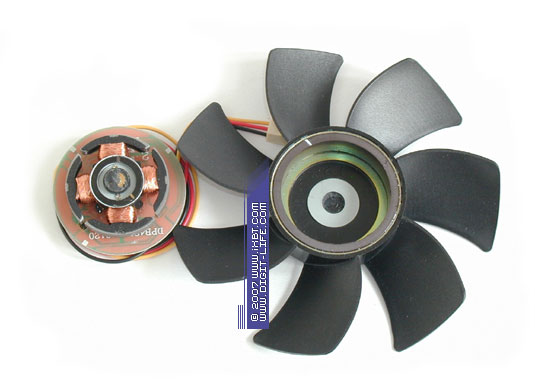 Stator and impeller of Scythe S-Flex These models also look well in aerodynamic terms — parameters of their impeller are intended to reduce noise while preserving the good efficiency potential: sweep and lean blades, the chord is 22 mm at the hub and 32 mm at the tip, chord-pitch ratio - 1.1 at the hub and 0.64 at the tip, angles of attack - 40° and 30°, 0.42 hub-tip ratio, 0.8 mm tip clearance. 
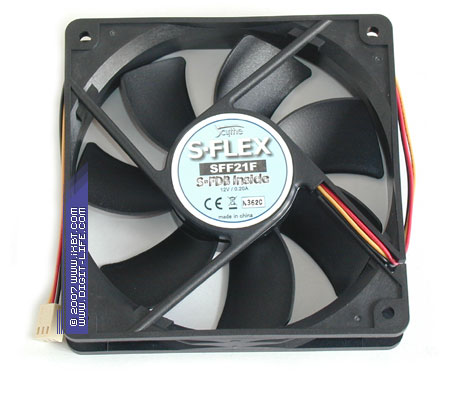 The SFF21E and SFF21F also have an interesting electric binding of the engine: along with a neat inductor, the fans are equipped with an unusual IC based on Sanyo LA6583. This chip has an interesting feature - the load (inductor) is connected as a bridge between driver outputs (that is it's a single-coil inductor), so coil switching (switching a single coil between drivers) is smoothed a priori. It looks like a magic recipe to eliminate engine popping once and for all. But it's not that simple in practice — the voice of the SFF21E and SFF21F has a noticeable electric noise, which volume compares to usual fans with noise filters based on capacitors. What concerns their results, these fans perform well in the standard mode (1600 rpm for the SFF21F and 1200 rpm). They demonstrate good performance and an acceptable efficiency/noise ratio. They also fare well at 1000 rpm, actively competing with Minebea models and SilentBlade II fans from GlacialTech. But efficiency of the SFF21E and SFF21F at low speed (700 rpm) slumps — which actually moves them towards outsiders in our today's shootout. The image of our fans suffers from another not-quite-positive issue in the standard mode as well — the noise generated by the SFF21E and SFF21F includes tonal coloring in this mode that subjectively makes it louder. The problem seems to be in the nonoptimal disposition of stator's holders, which results in acoustic mismatch of the impeller and fan case. Titan TFD-8025L12S, TFD-8025L12B, TFD-8025M12C, and TFD-8025H12BNow we are going to examine four 80x80x25 mm budget models from Titan — TFD-8025L12S, TFD-8025L12B, TFD-8025M12C and TFD-8025H12B. They have a similar design (identical fan cases, stator-impeller units, electronics). The differences come down to bearing types and nominal fan speeds. 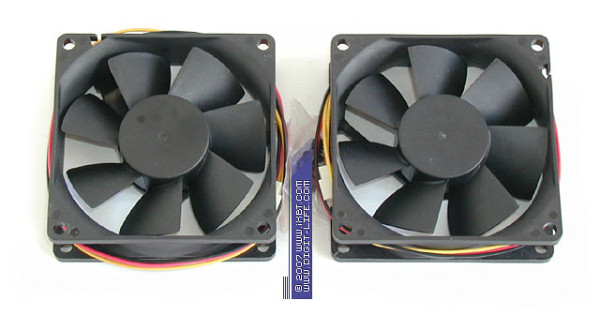
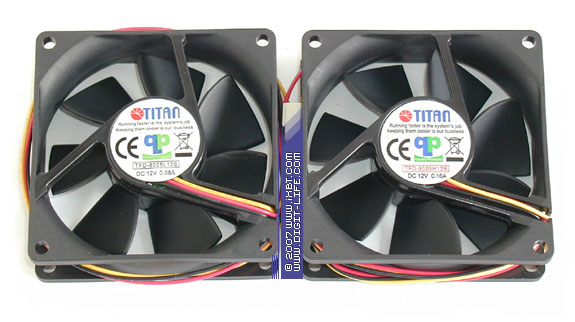 80 mm models from Titan look archaic in aerodynamic terms — straight blades, no fashionable sweep and lean blades or variable angles of attack (40° at the hub and 35° at the tip). the other parameters are quite tolerable: the chord is 18 mm at the hub and 26 mm at the tip, chord-pitch ratio is 1.12 at the hub and 0.81 at the outer diameter, 0.46 hub-tip ratio, 1.5 mm tip clearance. However, keeping in mind the straight blade, we should note even during the primary inspection that noise characteristics of these fans with such blades will hardly be optimal or ergonomic.  Besides, we don't like mechanics in these budget models, especially in the TFD-8025L12S, based on plain bearing, which cannot hold grease: even though it has a plastic cap, oil flows out of the bearing even after several days of tests. Perhaps, the hub and sleeve will be mated dry in a couple of months. 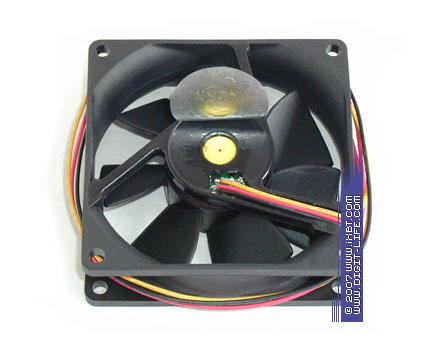 Models with rolling bearings (two rolling bearings in the TFD-8025L12B and TFD-8025H12B, rolling bearing plus sleeve bearing in the TFD-8025M12C) look more imposing. But we still have gripes with their quality — the bearings they use have a low accuracy class, a noticeable backlash, and they are noisy (hissing and sometimes crackling). 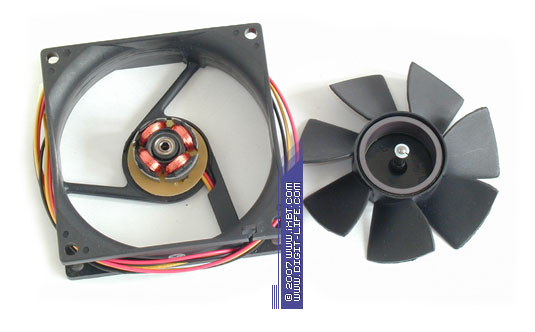 The electric binding of the engine also leaves much to be desired: the inductor is controlled by the S211 chip, which implies using smoothing capacitors; but there are no capacitors installed on the PCB. The result is expectable — Titan's 80 mm models are audibly crackling. Subjectively, this noise is even louder than in criticized Arctic Cooling Arctic Fan 8 and Cooler Master SAF-B83-E1-GP. 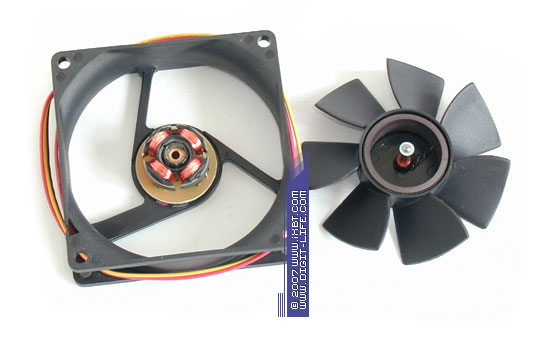 These fans are in-and-out performers. For example, the TFD-8025H12B at nominal speed (3000 rpm) demonstrates the best efficiency among 80x80x25 mm models. But this success comes at a high price — it's too noisy (its noise comes up to the red mark of 50 dBA) and features a well-defined tonality (typical howling of the impeller). So the fan sounds very irritating. The TFD-8025M12C (2500 rpm) is also quite noisy, it's close to its elder brother in efficiency/noise ratio. Only the "junior" TFD-8025L12S and TFD-8025L12B (2000 rpm) look decent — they manage to combine good efficiency with ergonomic noise. But even they are rather noisy compared to other contenders. 80 mm models from Titan also demonstrate weak results at 1500 rpm — their noise characteristics in this mode are better, of course, but their performance drops as well. Titan TFD-12025SL12Z, TFD-12025SL12B, and TFD-12025H12BThree other budget fans from Titan (TFD-12025SL12Z, TFD-12025SL12B, and TFD-12025H12B) belong to the 120x120x25 mm group. These fans, just like 80 mm models, have the same design and differ only in nominal speeds and bearings. 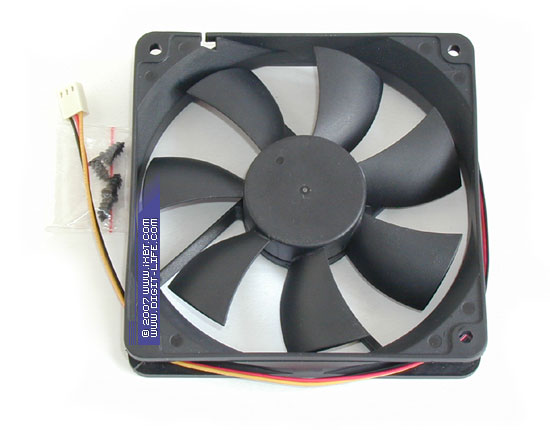 Titan TFD-12025H12B At first glance, aerodynamic configuration of the TFD-12025SL12Z, TFD-12025SL12B and TFD-12025H12B looks better than that of 80 mm models — sweep and lean blades and its variable angles (45° at the hub and 25° at the tip) are quite state-of-the-art. But a closer inspection reveals that the parametric assembly of the 120 mm impeller is not optimal: underdeveloped chord (17 mm at the hub and 30 mm at the tip), widely-ramified blades — chord-pitch ratio - 0.85 at the hub and 0.62 at the tip (it's the only impeller, which solidity factor is below 1 at the hub-blade junction) and excessively large tip clearance — 3 mm (that is 10% of the chord and 2.5% of the diameter). 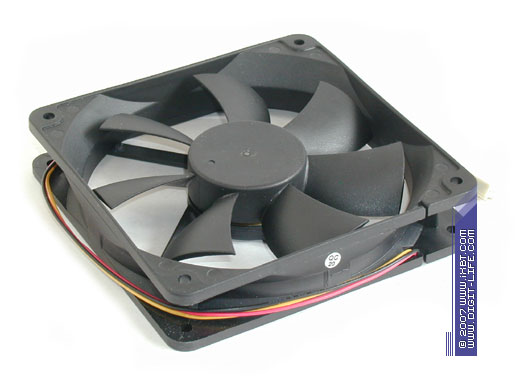
 Mechanical components of these 120 mm models are not inspiring either — while the TFD-12025SL12B and TFD-12025H12B can offer two rolling bearings, even if not of the highest quality, the TFD-12025SL12Z has nothing to boast of: this fan demonstrates a plain bearing, which does not justify its arcane title - Z-bearing (the only "innovation" here is a soft rubber ring on the spindle under the lock washer and a plastic gasket on top of the bearing unit - ordinary elements for a plain bearing designed in mid 90's of the last century, when manufacturers did not save on each particle). 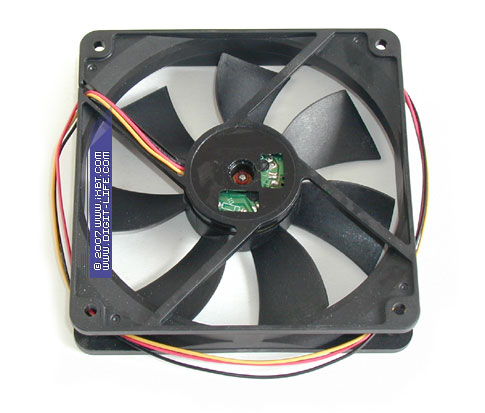 There is some progress in the electric part: Operating circuit of the TFD-12025SL12Z and TFD-12025SL12B copies the electrical binding of 80 mm models. But it also has smoothing capacitors at the outputs of coil drivers. Electronics of the TFD-12025H12B include the ATS177 pre-driver with a transistor stage at the output, which is also spiced up with smoothing capacitors. As a result, engine popping is muffled well and does not irritate you. 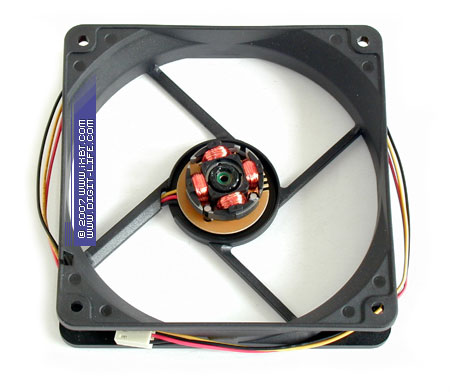 What concerns pure practice, the TFD-12025SL12Z, TFD-12025SL12B and TFD-12025H12B perform just like their 80 mm brothers — good performance results in the standard mode are clouded by a high noise level. And the drop in efficiency in a slower mode cannot be compensated by ergonomic noise characteristics. This trend is fully revealed at 700 rpm, where these fans are outperformed practically by all competitors, evidently because of the nonoptimal aerodynamic configuration of the impeller. Zalman ZM-F1 and ZM-F3Zalman fans conclude our today's shootout — ZM-F1 (80x80x25 mm, 3000 rpm) and ZM-F3 (120x120x25 mm, 1800 rpm). 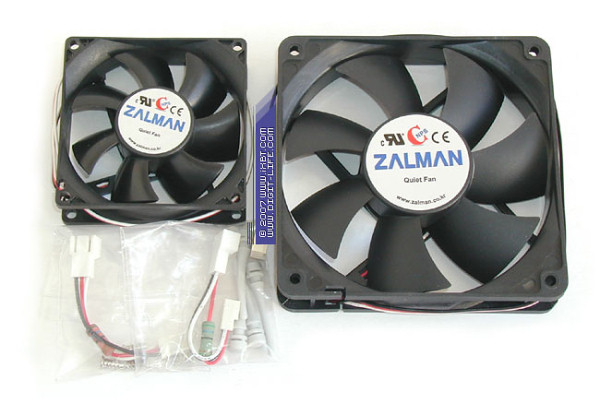 Trying to follow the brand policy of Zalman, which major point is noise ergonomics of cooling systems, ZM-F1 is also designed for reduced noise. It's especially noticeable in the sparing aerodynamic configuration of the 7-blade impeller — sweep and lean blades, the chord is 18 mm at the hub and 26 mm at the tip, chord-pitch ratio - 1.12 at the hub and 0.81 at the tip, angles of attack - 45° and 30°, 0.46 hub-tip ratio, 1.5 mm tip clearance. 
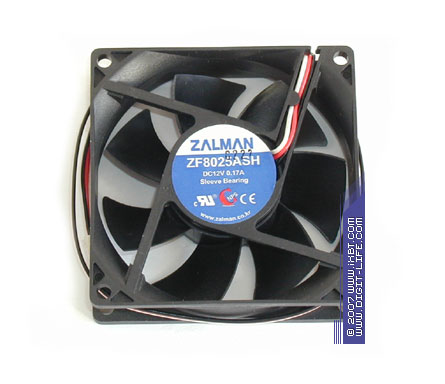 The electric part of this model is also neat — ZM-F1 demonstrates a nice operating circuit based on the ATS276 chip and spiced up with smoothing capacitors connected to the outputs of inductor's drivers. As a result, electric harmonics in fan noise abate to acceptable minimum. But the mechanical part of the ZM-F1 is far from inspiring. This fan is based on a simple sleeve bearing (a trivial budget-level sleeve) with insignificant improvements - a soft ring under the lock washer on the spindle and a rubber plug for the bearing on the side of stator's backing plate. Frankly speaking, we expected from Zalman a better attitude towards fan mechanics. ZM-F1 performance is also disappointing. While it's doing well in normal mode (3000 rpm), combining good efficiency with an acceptable noise level, its performance deteriorates in silent mode (1500 rpm) drastically. So this fan becomes an absolute outsider of today's shootout, being outscored even by the weak frameless Arctic Cooling Arctic Fan 8L. To all appearances, engineers paid too much attention to noise characteristics of the ZM-F1 impeller, missed something in their calculations, and it resulted in significant performance losses at low speeds. Aerodynamic configuration of the other fan from Zalman (ZM-F3) looks better — its seven-blade impeller is designed not only for noise ergonomics, but also to preserve sufficient efficiency potential: sweep and lean blades, the chord is 24 mm at the hub and 36 mm at the tip, chord-pitch ratio - 1.1 at the hub and 0.73 at the tip, angles of attack - 40° and 25°, 0.42 hub-tip ratio, 1.5 mm tip clearance. 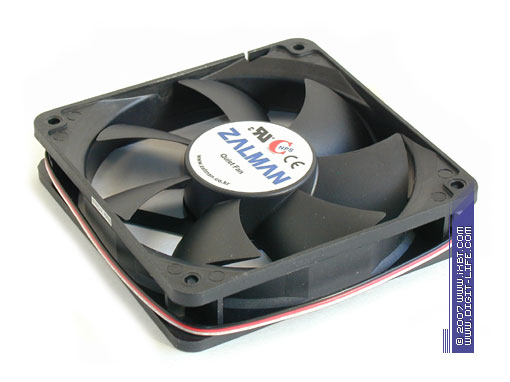
 The ZM-F3 also looks good from the electronic point of view — the fan is equipped with a neat inductor and an operating circuit based on the ATS177 pre-driver with an output transistor stage. There are also some capacitors that smooth coil switching impulses. And they cope with their task well — engine popping is almost inaudible in the ZM-F3.  Although this fan is still not very good from the mechanical point of view (ZM-F1 and ZM-F3 are equipped with similar plain bearings), it performs much more efficiently and demonstrates decent results both in the normal mode (1800 rpm) and in silent mode (1000 rpm). The ZM-F3 also performs well at 700 rpm — here it demonstrates respectable performance and combines it with truly ergonomic noise characteristics. So we've examined all our contenders for today, their technical overview is completed. It's time to have a look at the test results!
Contents:
Vitali Crinitsin (vit@ixbt.com)
June 8, 2007 Write a comment below. No registration needed!
|
Platform · Video · Multimedia · Mobile · Other || About us & Privacy policy · Twitter · Facebook Copyright © Byrds Research & Publishing, Ltd., 1997–2011. All rights reserved. |